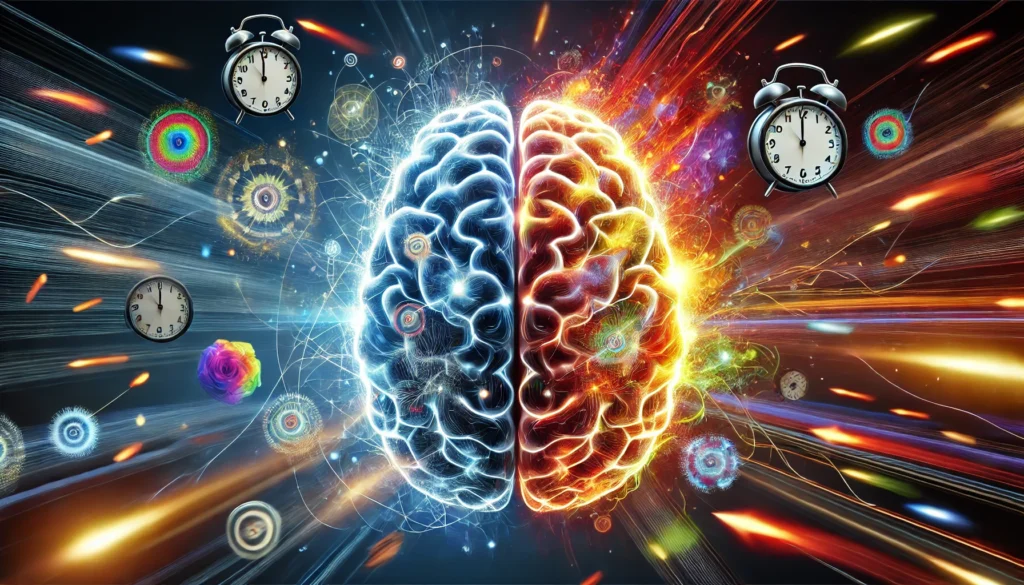In today’s fast-paced world, understanding the nuances of attention deficit hyperactivity disorder (ADHD) is more important than ever. Among the different presentations of ADHD, the combined type, also known as mixed ADHD or ADHD combined presentation, stands out due to its complexity and the breadth of symptoms it encompasses. This article aims to provide a detailed overview of combined ADHD, exploring its symptoms, historical context, current trends, and potential future implications.
You may also like: Enhancing Concentration: Strategies for ADHD
What is Combined ADHD?
Combined ADHD is a presentation of attention deficit hyperactivity disorder that includes a mix of symptoms from both the inattentive and hyperactive-impulsive categories. This means individuals with this type of ADHD exhibit behaviors related to both inattentiveness and hyperactivity-impulsivity. It is the most common presentation of ADHD, affecting both children and adults.
Understanding ADHD
ADHD is a neurodevelopmental disorder characterized by a persistent pattern of inattention and/or hyperactivity-impulsivity that interferes with functioning or development. Historically, ADHD has been categorized into three primary presentations: predominantly inattentive, predominantly hyperactive-impulsive, and combined.
The combined presentation is particularly noteworthy because it involves symptoms from both of the other categories. This makes it a more challenging condition to diagnose and manage, as the individual displays a wider range of behaviors. Furthermore, the overlap of symptoms can often lead to misdiagnosis or underdiagnosis, as healthcare providers might overlook the dual nature of the disorder.
Inattentive Symptoms
Inattentive symptoms in combined ADHD can be subtle yet pervasive. Individuals often experience difficulty sustaining attention, frequent careless mistakes, forgetfulness, and a tendency to become easily distracted. These symptoms can manifest in various environments, from academic settings where focus is crucial to daily activities such as following recipes or completing chores.
The challenge of maintaining attention can significantly impact one’s ability to organize tasks and prioritize activities. This can lead to feelings of frustration and overwhelm, which may exacerbate other symptoms or contribute to additional stress. Understanding the specific ways in which inattention presents can help in developing targeted strategies for management.
Hyperactivity-Impulsivity Symptoms
Hyperactivity-impulsivity symptoms are often more overt and can include restlessness, frequent fidgeting, talking excessively, difficulty waiting for their turn, and impulsively making decisions without considering consequences. These behaviors can lead to difficulties in maintaining social relationships and achieving professional success.
In social contexts, impulsive actions or words might result in misunderstandings or conflicts, while in professional environments, the inability to sit still or wait patiently can be perceived as disruptive or lacking discipline. Recognizing these symptoms as part of a broader disorder can help mitigate misunderstandings and foster more supportive interactions.
Challenges in Diagnosis
Diagnosing combined ADHD is a complex process that requires a nuanced understanding of both inattentive and hyperactive-impulsive symptoms. The presence of both symptom types can sometimes mask the severity or presence of one category over the other, complicating the diagnostic process.
Healthcare professionals rely on a combination of clinical interviews, behavioral assessments, and input from family members or teachers to make an accurate diagnosis. A comprehensive evaluation is crucial to differentiate combined ADHD from other disorders with overlapping symptoms, such as anxiety or mood disorders.

Historical Context of ADHD
The concept of ADHD has evolved significantly over the years. The disorder was first described in the medical literature in 1902 by British pediatrician Sir George Still, who noted a group of children exhibiting symptoms of impulsivity and behavioral problems. However, it wasn’t until the late 20th century that ADHD became widely recognized and understood as a neurodevelopmental disorder.
Early Descriptions and Misunderstandings
In the early 20th century, ADHD symptoms were often misunderstood or attributed to moral failings or poor parenting. Children exhibiting hyperactivity or inattention were frequently labeled as troublemakers or lacking discipline. These misconceptions hindered the development of appropriate interventions and support systems.
As research progressed, the understanding of ADHD shifted towards recognizing it as a legitimate neurodevelopmental disorder. This shift was pivotal in changing societal perceptions and advocating for more supportive educational and therapeutic environments.
Evolution of Diagnostic Criteria
The diagnostic criteria for ADHD have undergone numerous revisions over the years. Initially, the focus was primarily on hyperactivity, with less emphasis on inattention. As research expanded, the recognition of inattentive symptoms as a critical component of ADHD led to the identification of different presentations, including the combined type.
These evolving criteria have allowed for more precise diagnoses and have informed the development of tailored treatment plans. The recognition of combined ADHD as a distinct presentation has been instrumental in advancing research and improving outcomes for those affected.
Impact of Societal Changes
Societal changes have also influenced the understanding and perception of ADHD. The increasing pace of modern life and the rise of technology have highlighted the challenges faced by individuals with ADHD, particularly in environments that demand sustained attention and rapid task-switching.
As awareness of ADHD has grown, so too has the recognition of its impact across the lifespan. This has led to an increased focus on understanding ADHD in adults and developing strategies to support individuals beyond childhood.
Current Trends in ADHD Diagnosis and Treatment
In recent years, there has been a growing awareness of ADHD and its various presentations, including combined ADHD. This has led to improvements in diagnosis and a broader range of treatment options.
Advances in Diagnostic Techniques
Advancements in diagnostic techniques have improved the accuracy of ADHD diagnoses. Clinicians now have access to a range of tools, from computerized cognitive tests to neuroimaging technologies, which can provide deeper insights into the neurological underpinnings of ADHD.
Despite these advancements, the diagnostic process remains complex and requires a holistic approach. Combining technological tools with traditional assessments ensures a comprehensive understanding of each individual’s unique symptom profile.
Medication Developments
Medication remains a cornerstone of ADHD treatment, with new formulations and delivery methods continually being developed. Stimulant medications, such as methylphenidate and amphetamines, are commonly prescribed, but non-stimulant options are also available for those who may not respond well to stimulants.
The development of extended-release formulations has improved the management of symptoms throughout the day, reducing the need for multiple doses. Ongoing research into the long-term effects of medication and the potential for personalized pharmacological approaches is promising.
Behavioral and Alternative Therapies
Behavioral therapy is an essential component of ADHD treatment, focusing on developing coping strategies and improving organizational skills. This approach empowers individuals to manage their symptoms in daily life, complementing the effects of medication.
Additionally, there is increasing interest in alternative treatments, such as mindfulness practices, dietary modifications, and biofeedback. These approaches aim to address ADHD symptoms in a holistic manner, promoting overall mental health and well-being. Incorporating these methods into treatment plans can offer additional support and enhance quality of life.

Future Implications and Research Directions
The field of ADHD research is rapidly evolving, with new insights and treatments emerging regularly. For individuals with combined ADHD, future research holds the promise of more personalized and effective interventions.
Personalized Medicine
One promising area of research is personalized medicine, which involves tailoring treatment plans based on an individual’s genetic makeup, lifestyle, and specific symptom profile. This approach could lead to more effective management of combined ADHD, reducing the trial-and-error process often associated with finding the right treatment.
By analyzing genetic markers and understanding individual differences in drug metabolism, personalized medicine aims to optimize treatment efficacy and minimize side effects. This approach represents a significant shift towards more precise and individualized care.
Technological Advancements
Technological advancements are also playing a significant role in the future of ADHD treatment. Mobile apps and digital platforms are being developed to provide real-time symptom tracking and personalized feedback. These tools can empower individuals with combined ADHD to better manage their symptoms and improve their quality of life.
Virtual reality and gamification are also being explored as therapeutic tools to enhance focus and reduce impulsivity. These innovative approaches have the potential to engage individuals in new and effective ways, transforming the landscape of ADHD treatment.
Continued Advocacy and Awareness
Continued advocacy and awareness efforts are crucial in ensuring that individuals with combined ADHD receive the support and resources they need. By promoting understanding and reducing stigma, we can create a more inclusive society where individuals with ADHD can thrive.
Educational campaigns and public policy initiatives are essential in fostering environments that accommodate the needs of those with ADHD. By advocating for accessible resources and equitable opportunities, we can empower individuals to reach their full potential.

Practical Advice for Managing Combined ADHD
For those living with combined ADHD, managing symptoms can be a daily challenge. Here are some practical strategies that may help:
Establish Routines
Creating a structured daily routine can help reduce inattention and impulsivity. Use planners or digital calendars to keep track of tasks and appointments. Consistency is key, as it provides a framework within which individuals can better manage their time and responsibilities.
Incorporating regular breaks and setting clear boundaries between work and leisure can also enhance focus and prevent burnout. Establishing routines that prioritize both productivity and self-care is crucial in managing combined ADHD effectively.
Break Tasks into Smaller Steps
Large tasks can be overwhelming for individuals with ADHD. Breaking them into smaller, manageable steps can make them feel more achievable. This approach can reduce anxiety and increase motivation, as individuals experience a sense of accomplishment with each completed step.
Utilizing checklists and progress trackers can further enhance this strategy, providing visual reinforcement of progress and helping individuals stay on track. Encouraging the use of these tools can foster a sense of control and efficacy.
Mindfulness and Relaxation Techniques
Practices such as meditation, deep breathing, and yoga can help improve focus and reduce hyperactivity. These techniques promote relaxation and self-awareness, enabling individuals to better regulate their emotions and responses.
Incorporating mindfulness into daily routines can enhance overall well-being, providing a buffer against the stressors and challenges associated with ADHD. Encouraging regular practice can lead to long-term benefits in managing symptoms.
Seek Professional Support
Working with a therapist or coach who specializes in ADHD can provide valuable guidance and support. Professional support can offer tailored strategies and interventions, helping individuals navigate the complexities of combined ADHD.
Therapists and coaches can also provide accountability and encouragement, fostering a sense of community and connection. Engaging with professionals who understand the nuances of ADHD can significantly enhance the effectiveness of management strategies.
In conclusion, combined ADHD is a complex and multifaceted condition that requires a comprehensive approach to diagnosis and treatment. By understanding its symptoms, historical context, and current trends, individuals and healthcare providers can work together to develop effective strategies for managing this challenging disorder.
Further Reading:
Attention-Deficit / Hyperactivity Disorder (ADHD) in Children
Attention-Deficit/Hyperactivity Disorder Combined in Adults
Attention-Deficit/Hyperactivity Disorder (ADHD)
Important Note: The information contained in this article is for general informational purposes only, and should not be construed as health or medical advice, nor is it intended to diagnose, prevent, treat, or cure any disease or health condition. Before embarking on any diet, fitness regimen, or program of nutritional supplementation, it is advisable to consult your healthcare professional in order to determine its safety and probable efficacy in terms of your individual state of health.
Regarding Nutritional Supplements Or Other Non-Prescription Health Products: If any nutritional supplements or other non-prescription health products are mentioned in the foregoing article, any claims or statements made about them have not been evaluated by the U.S. Food and Drug Administration, and such nutritional supplements or other health products are not intended to diagnose, treat, cure, or prevent any disease.


